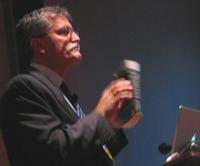
Georgia Briscoe introduced Roy Tennant, who talked about ten new technologies and trends he thought particularly interesting for librarians.
1. Other organizations taking our users, i.e.: Google Scholar. What something like Google Scholar means is that increasingly, users are coming to our sites from places we’re not expecting, meaning they may be confronted with “you’re not an authorized user” messages which we may wish to rethink.
2. Web 2.0. This term refers to web sites that actually assemble stuff for the viewer on the fly. Tennant cited as an example Chicagocrime.org, which takes crime data and combines it with the Google maps capability to give the user maps of crimes for addresses that the user enters.
3. Collaborative filtering. Sites like unalog.com or del.icio.us, where are websites on which people can post links of interest to them. These sites, essentially updates via RSS feed of people’s bookmarks are good for communities of users with similar interests. Libraries must want to consider having this type of thing on their websites.
4. Institutional repositories. These serve to capture the intellectual output of institutions, and are often great places to find gray literature as well as for scholarship before it is published. Tennant cited two sites: University of California’s repository at repositories.cdlib.org and MIT’s Dspace at dspace.mit.org. They can get phenomenal usage (often referred by Google). They’re also important in the Open Access movement, in that materials posted here are then available to the public at no cost.
5. OAI-PMH (Open archives initiative protocol for metadata harvesting). Harvests metadata from institutional repositories, making them searchable. Examples include OAIster at the University of Michigan, and the Public Knowledge Project’s Open Archives Harvester.
6. MODS, or metadata object description schema, which is like MARC, but in XML. Being developed at LC by a group of interested people. See www.loc.gov/standards/mods
7. METS, or metadata encoding and transmission standard, which Tennant described as an XML wrapper for various metadata packages. METS can impose a structure. See www.loc.gov/standards/mets
8. RSS, which stands for Really Simple Syndication, an easy way of automatically compiling updating from a selection of websites automatically. Tennant cited the Yorba Linda Public Library’s RSS feed from the Librarians’ Index to the Internet. Other libraries could easily set up RSS feeds from selections of sites of interest to them.
9. Going beyond the card catalog. Tennant advocates enriched catalogs which metadata from wherever they find it and combine it in the way must useful to users. Tennant discussed using scanned TOCs (but NOT in the form commonly used in 505 fields), ONIX records from publishers, authority records, readers reviews to put together enriched catalogs. FRBR can help here, as seen in RLG’s redlightgreen, or other OCLC products still in development.
10. Metasearching. The ability to search two or more sites simultaneously. This is still “early days,” and by no means perfected, but shows promise. Tennant cited the University of Rochester Library’s article finding feature as a example of where this works well. Tennant closed by listing guidelines for making good technology decisions, and a list of helpful truisms. See TSLL for a fuller report!
